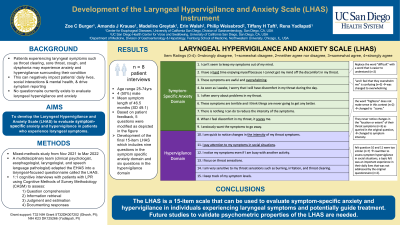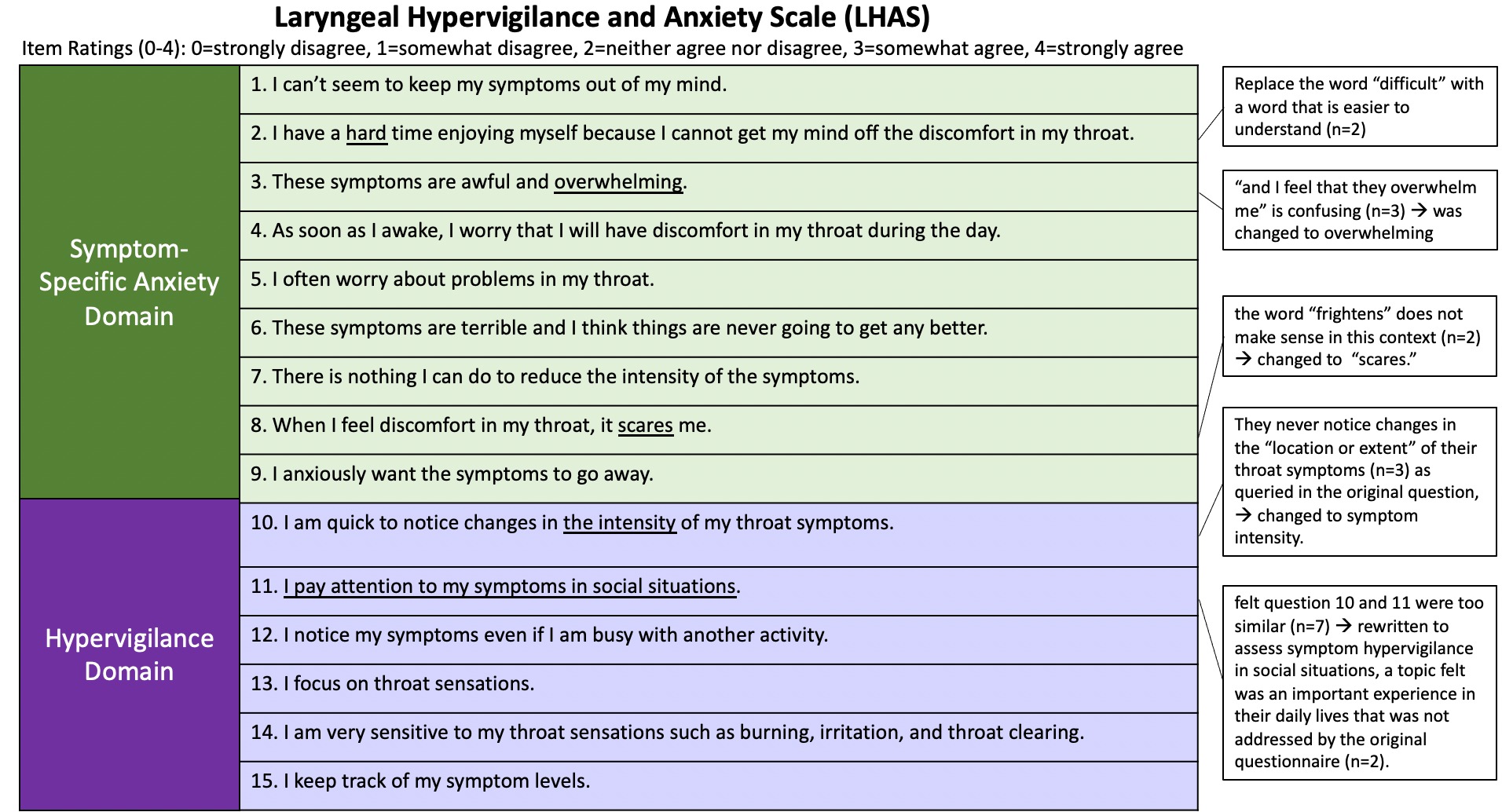Back


Poster Session B - Monday Morning
Category: Esophagus
B0208 - Development of the Laryngeal Hypervigilance and Anxiety Scale (LHAS) Instrument
Monday, October 24, 2022
10:00 AM – 12:00 PM ET
Location: Crown Ballroom

Has Audio

Zoe Burger, BA
University of California San Diego School of Medicine
Irvine, CA
Presenting Author(s)
Zoe C. Burger, BA1, Amanda J. Krause, MD1, Madeline Greytak, BA1, Erin Walsh, MA1, Philip Weissbrod, MD1, Tiffany H. Taft, PsyD2, Rena Yadlapati, MD, MS1
1University of California San Diego School of Medicine, La Jolla, CA; 2Northwestern University Feinberg School of Medicine, Chicago, IL
Introduction: Patients experiencing laryngeal symptoms such as throat clearing, sore throat, cough, and dysphonia may experience anxiety and hypervigilance surrounding their condition. These cognitive-affective processes can negatively impact patients’ daily lives, social interactions and mental health, and can drive symptom reporting. The Esophageal Hypervigilance and Anxiety Scale (EHAS) is a validated instrument used to evaluate anxiety and hypervigilance surrounding esophageal symptoms. However, there is currently no questionnaire designed to evaluate laryngeal hypervigilance and anxiety, which may differ due to symptoms being concentrated in the throat. We aimed to develop the Laryngeal Hypervigilance and Anxiety Scale (LHAS) to evaluate symptom-specific anxiety and hypervigilance in patients who experience laryngeal symptoms.
Methods: This mixed-methods prospective study was performed from November 2021 to March 2022. A multidisciplinary team (clinical psychologist, esophagologist, laryngologist, and speech language pathologist) drew from the EHAS to propose items for the LHAS. The preliminary LHAS was evaluated through 1:1 cognitive interview with 8 patients with LPR using the Cognitive Methods of Survey Methodology (CASM) to assess: 1) Question comprehension, 2) Information retrieval, 3) Judgment and estimation, 4) Documenting responses. Data collected during the interviews were reviewed with the multidisciplinary team.
Results: Eight patients completed interviews: age range 25 to 74 years, 4 (50%) male, and mean symptom length of 46.5 months (SD 49.1). During participants response review with the multidisciplinary team, 5 EHAS questions were ultimately modified resulting in development of the final 15-item LHAS (Figure 1); two in the domain of laryngeal symptom hypervigilance and three in the domain of laryngeal symptom specific anxiety. Based on patient feedback, questions 2, 3, and 8 were reworded. Question 10 was changed to assess symptom intensity instead of the location or extent of throat symptoms. Questions 10 and 11 were felt to be too similar, so question 11 was revised to instead assess symptom hypervigilance in social situations.
Discussion: The LHAS is a 15-item scale that can be used to evaluate symptom-specific anxiety and hypervigilance in individuals experiencing laryngeal symptoms and potentially guide treatment. Future studies to validate psychometric properties of the LHAS are needed.

Disclosures:
Zoe C. Burger, BA1, Amanda J. Krause, MD1, Madeline Greytak, BA1, Erin Walsh, MA1, Philip Weissbrod, MD1, Tiffany H. Taft, PsyD2, Rena Yadlapati, MD, MS1. B0208 - Development of the Laryngeal Hypervigilance and Anxiety Scale (LHAS) Instrument, ACG 2022 Annual Scientific Meeting Abstracts. Charlotte, NC: American College of Gastroenterology.
1University of California San Diego School of Medicine, La Jolla, CA; 2Northwestern University Feinberg School of Medicine, Chicago, IL
Introduction: Patients experiencing laryngeal symptoms such as throat clearing, sore throat, cough, and dysphonia may experience anxiety and hypervigilance surrounding their condition. These cognitive-affective processes can negatively impact patients’ daily lives, social interactions and mental health, and can drive symptom reporting. The Esophageal Hypervigilance and Anxiety Scale (EHAS) is a validated instrument used to evaluate anxiety and hypervigilance surrounding esophageal symptoms. However, there is currently no questionnaire designed to evaluate laryngeal hypervigilance and anxiety, which may differ due to symptoms being concentrated in the throat. We aimed to develop the Laryngeal Hypervigilance and Anxiety Scale (LHAS) to evaluate symptom-specific anxiety and hypervigilance in patients who experience laryngeal symptoms.
Methods: This mixed-methods prospective study was performed from November 2021 to March 2022. A multidisciplinary team (clinical psychologist, esophagologist, laryngologist, and speech language pathologist) drew from the EHAS to propose items for the LHAS. The preliminary LHAS was evaluated through 1:1 cognitive interview with 8 patients with LPR using the Cognitive Methods of Survey Methodology (CASM) to assess: 1) Question comprehension, 2) Information retrieval, 3) Judgment and estimation, 4) Documenting responses. Data collected during the interviews were reviewed with the multidisciplinary team.
Results: Eight patients completed interviews: age range 25 to 74 years, 4 (50%) male, and mean symptom length of 46.5 months (SD 49.1). During participants response review with the multidisciplinary team, 5 EHAS questions were ultimately modified resulting in development of the final 15-item LHAS (Figure 1); two in the domain of laryngeal symptom hypervigilance and three in the domain of laryngeal symptom specific anxiety. Based on patient feedback, questions 2, 3, and 8 were reworded. Question 10 was changed to assess symptom intensity instead of the location or extent of throat symptoms. Questions 10 and 11 were felt to be too similar, so question 11 was revised to instead assess symptom hypervigilance in social situations.
Discussion: The LHAS is a 15-item scale that can be used to evaluate symptom-specific anxiety and hypervigilance in individuals experiencing laryngeal symptoms and potentially guide treatment. Future studies to validate psychometric properties of the LHAS are needed.

Figure: 15-item Laryngeal Hypervigilance and Anxiety Scale. Green cells denote items specific to symptom-specific anxiety and purple cells denote items specific to hypervigilance. Modifications from the original questionnaire are underlined, and reason for modification are described in the boxes.
Disclosures:
Zoe Burger indicated no relevant financial relationships.
Amanda Krause indicated no relevant financial relationships.
Madeline Greytak indicated no relevant financial relationships.
Erin Walsh indicated no relevant financial relationships.
Philip Weissbrod indicated no relevant financial relationships.
Tiffany Taft: Healthline – Consultant. Oak Park Behavioral Medicine LLC – Owner/Ownership Interest. Takeda – Consultant.
Rena Yadlapati: Ironwood Pharmaceuticals – Grant/Research Support. Medscape – Consultant. Medtronic – Consultant. Phathom Pharmaceuticals – Consultant. RJS Mediagnostix – Advisory Committee/Board Member.
Zoe C. Burger, BA1, Amanda J. Krause, MD1, Madeline Greytak, BA1, Erin Walsh, MA1, Philip Weissbrod, MD1, Tiffany H. Taft, PsyD2, Rena Yadlapati, MD, MS1. B0208 - Development of the Laryngeal Hypervigilance and Anxiety Scale (LHAS) Instrument, ACG 2022 Annual Scientific Meeting Abstracts. Charlotte, NC: American College of Gastroenterology.

